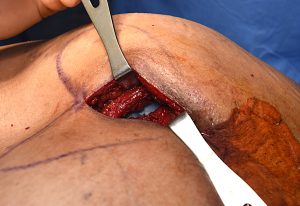Implants are the definitive buttock augmentation option in patients with inadequate fat harvest sites or who have had inadequate BBL (fat injection) results. The placement of buttock implants can be done in three different pocket locations, above the muscle (subfascial), inside the muscle (intramuscular) and below the muscle. (submuscular) No buttock implant pocket location is perfect and each has its advantages and disadvantages.

In the March 2024 issue of the Aesthetic Surgery Journal an article was published on this topic entitled ‘Submuscular Buttock Augmentation with Silicone Implants in 80 Female Patients’. Over a three year period (2019 – 2022) the authors performed 160 submuscular buttock implants in 80 patients. Only 7 patients required revisional surgery and two patients developed infections necessitating antibiotic therapy. No implant had to be removed. The authors noted that the bigger the implant placed the more likely was the risk of complications.
There is little question with an implant anywhere in the body that the more well vascularized soft tissue there is over it the lower the risk of complications and the better it will be maintained long term. The sub muscular buttock implant pocket fulfills that criteria somewhat similar to the submuscular location for breast implants. But unlike the pectoral submuscular pocket the gluteal submuscular pocket is more challenging to find, has a deeper less visible location and has significant neurovascular structures close to it. (i.e., the sciatic nerve) In my experience a certain percentage of patients will develop some temporary sciatic nerve symptoms which can be managed by steroids and Gabapentin and is self-resolving.
The authors also address an important issue….implant size. The submuscular pocket shares the same implant size limitations that the intramuscular pocket does. Implants sizes are going to be limited to the range of 250cc to 350ccs. As implant sizes become bigger dissection and placement becomes more difficult and the risks of complications also increases.
Dr. Barry Eppley
World-Renowned Plastic Surgeon


